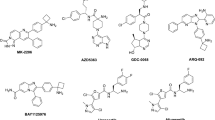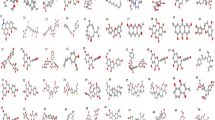Abstract
3D-QSAR and molecular docking analysis were performed to explore the interaction of estrogen receptors (ERα and ERβ) with a series of 3-arylquinazolinethione derivatives. Using the conformations of these compounds revealed by molecular docking, CoMFA analysis resulted in the first quantitative structure-activity relationship (QSAR) and first quantitative structure-selectivity relationship (QSSR) models predicting the inhibitory activity against ERβ and the selectivity against ERá. The q2 and R2 values, along with further testing, indicate that the obtained 3D-QSAR and 3D-QSSR models will be valuable in predicting both the inhibitory activity and selectivity of 3-arylquinazolinethione derivatives for these protein targets. A set of 3D contour plots drawn based on the 3D-QSAR and 3D-QSSR models reveal modifications of substituents at C2 and C5 of the quinazoline which my be useful to improve both the activity and selectivity of ERβ/ ERα. Results showed that both the steric and electrostatic factors should appropriately be taken into account in future rational design and development of more active and more selective ERβ inhibitors for the therapeutic treatment of osteoporosis.

Structures of ERβ binding with compounds 1aar, 1ax and 1aag obtained from molecular docking





Similar content being viewed by others
References
Robinson-Rechavi M, Escriva GH, Laudet V (2003) J Cell Sci 116:585–586
Kuiper GGJM, Enmark E, Pelto-Huikko M, Nilsson S, Gustafsson J-A (1996) Proc Natl Acad Sci 93:5925–5930
Mosselman S, Polman J, Dijkema R (1996) FEBS Lett 392:49–53
Kuiper GGJM, Gustafsson J-A (1997) FEBS Lett 410:87–90
Kuiper GGJM, Carlsson B, Grandien K, Enmark E, Haeggblad J (1997) 138:863–870
Dechering K, Boersma Ch, Mosselman S (2000) Curr Med Chem 7:561–576
Subhendu M, Achintya S, Kunal R (2005) BMC Lett 15:957–961
Timur G, Chen Y, Rajasree G, Ma ZP, James RC (2006) J Med Chem 49:2440–2455
Yang GF, Lu HT, Xiong Y, Zhan CG (2006) BMC 14:1462–1473
Irwin RA, Menezes AT, Carlos AM (2006) STEROIDS 71:417–428
Pike AC, Brzozowski AM, Hubbard RE, Bonn T, Thorsell AG, Engstrom O, Ljunggren J, Gustafsson JA, Carlquist M (1999) Embo J. 18:4608–4618
Manual S, Louis MO (2005) Tripos Inc Sybyl 7.1
Goodsell DS, Olson AJ (1990) 8:195–202
Morris GM, Goodsell DS, Huey R, Olson AJ (1996) 10:293–304
Morris GM, Goodsell DS, Halliday RS, Huey R, Hart WE, Belew RK, Olson AJ (1998) J Comp Chem 19:1639–1662
Solis FJ, Wets RJ (1981) B. Maths Pera Res 6:19–30
Weiner SJ, Kollman PA, Case DA, Singh C, Ghio G, Alagona S, Profeta P, Weiner PJ (1984) Am Chem Soc 106:765–771
Hu WX, Yun LH (1992) Chin Chem Lett 3:271–280
Pauling P, Datta N, Ramsay W, Forster R (1980) Proc Natl Acad Sci USA 77:708–721
Liu GX, Zhang ZS, Luo XM, Shen JH, Liu H, Shen X, Chen KX, Jiang HL (2004) BMC 12:1447–1457
Hawkins DM, Basak SC, Mills D (2003) J Chem Inf Comput Sci 43:579–586
Golbraikh A, Tropsha A (2002) J Mol Graph Model 20:269–276
Parker MA, Lewicka DM, Lucaites VL, Nelson DL, Nichols DE (1998) J Med Chem 41:5148–5162
Acknowledgements
This work is supported by the Scientific Research Common Program of Beijing Municipal Commission of Education. The authors are grateful to the kind help of Dr. Yuandong Hu and Miss Mei Zhou, Beijing Hongcam Software Technologies Co. Ltd.
Author information
Authors and Affiliations
Corresponding author
Rights and permissions
About this article
Cite this article
Xiao, A., Zhang, Z., An, L. et al. 3D-QSAR and docking studies of 3-arylquinazolinethione derivatives as selective estrogen receptor modulators. J Mol Model 14, 149–159 (2008). https://doi.org/10.1007/s00894-007-0264-x
Received:
Accepted:
Published:
Issue Date:
DOI: https://doi.org/10.1007/s00894-007-0264-x




